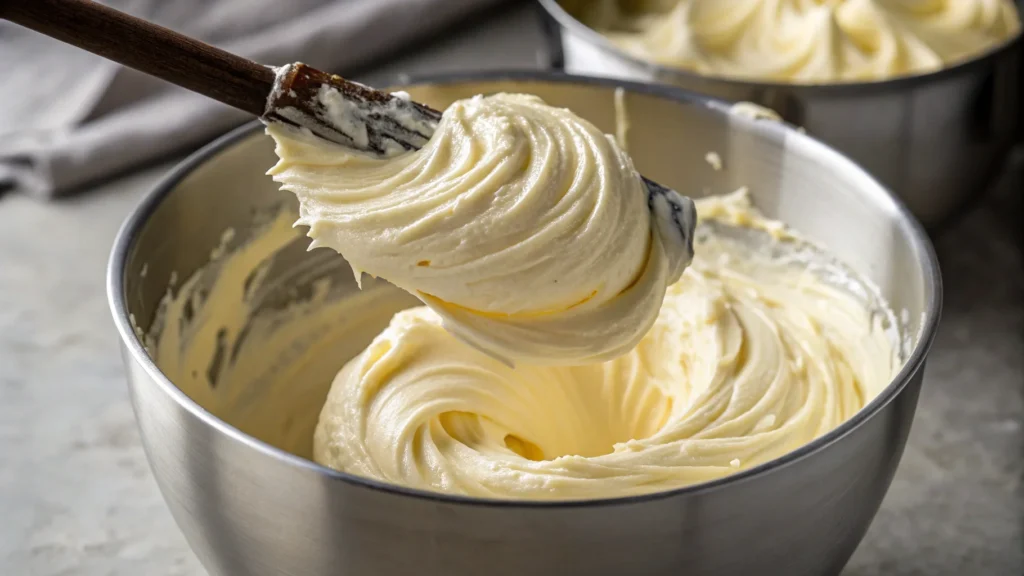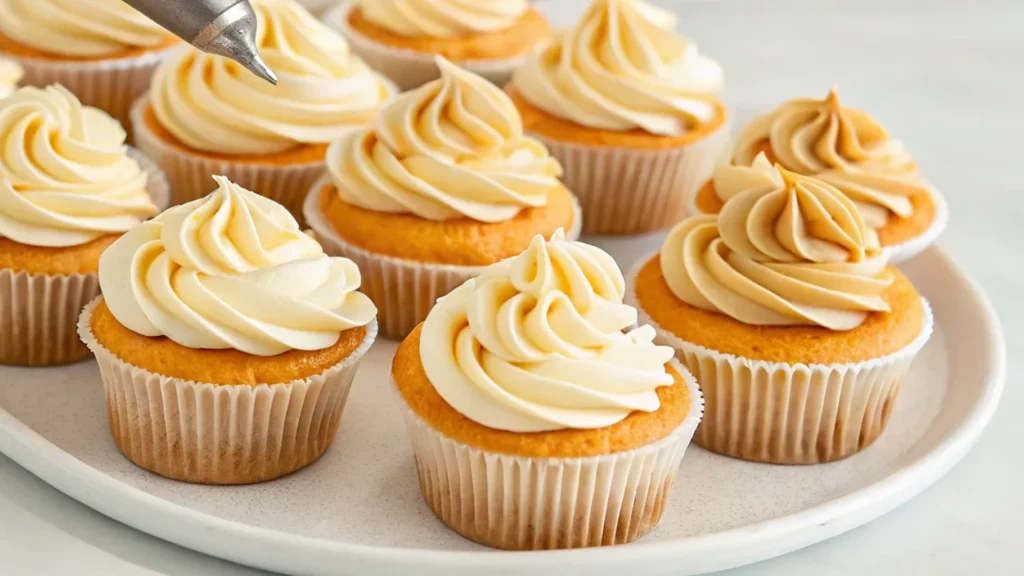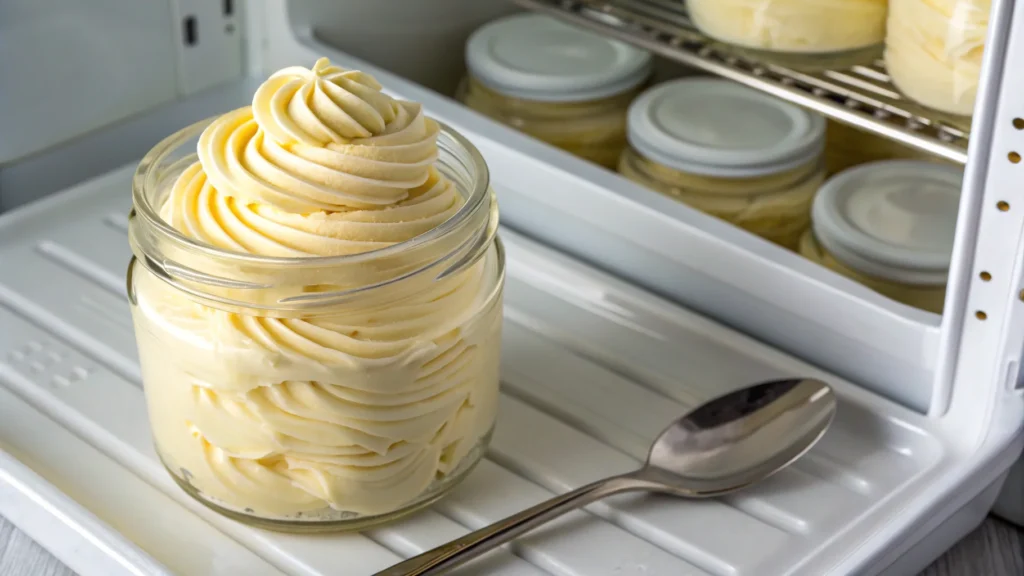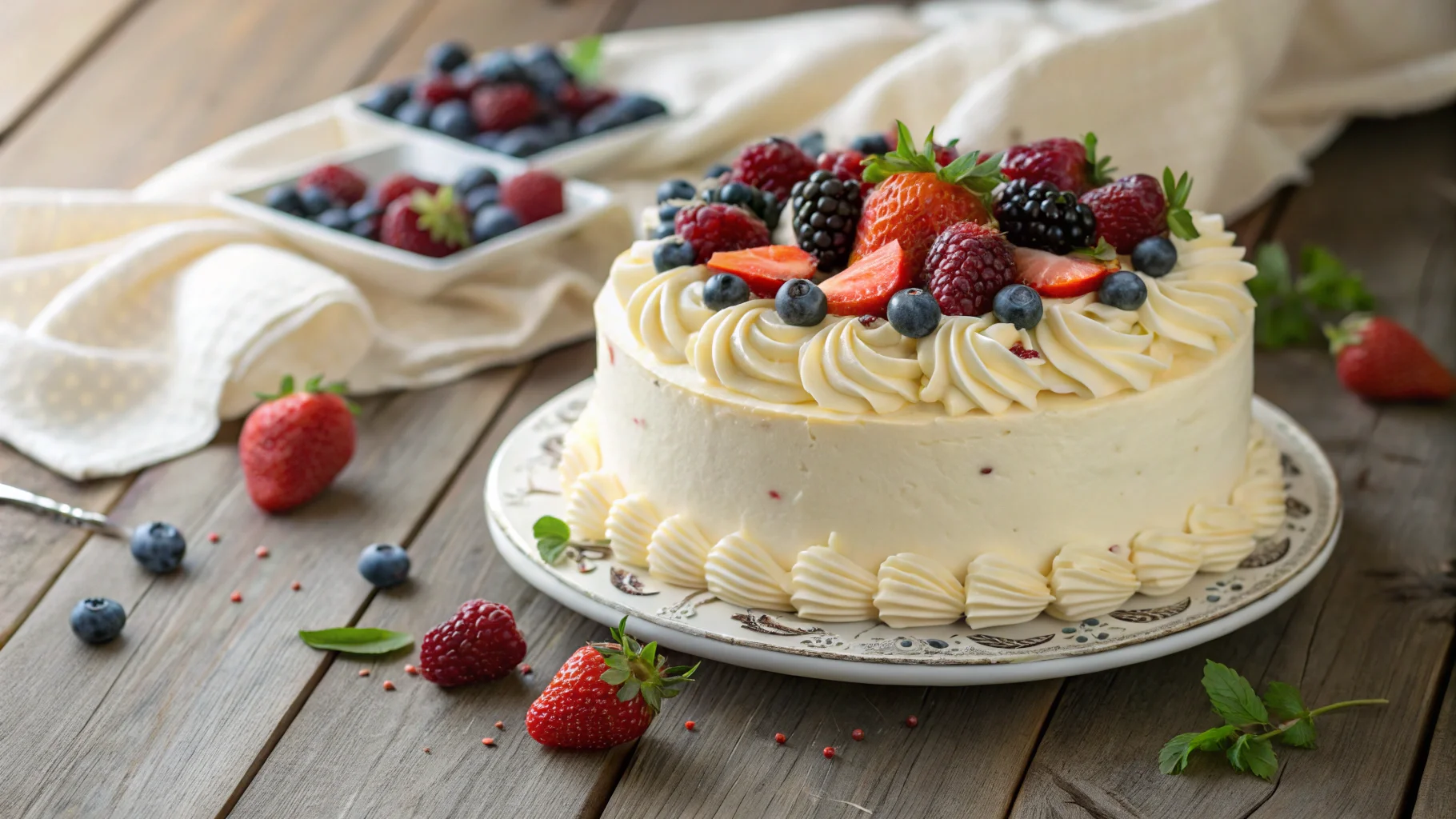When it comes to frosting that’s silky smooth, incredibly simple, and irresistibly delicious, Russian buttercream stands out. Unlike traditional buttercreams that rely on powdered sugar or egg whites, this frosting gets its signature texture from sweetened condensed milk, making it a dream for both beginners and experienced bakers.
In this guide, we’ll explore everything you need to know about Russian buttercream—from its origins and ingredients to step-by-step instructions, common troubleshooting issues, and expert decorating tips. Whether you’re looking to elevate your cake decorating skills or find a go-to frosting that’s less sweet and more stable, this article has you covered.
Table of contents
- What is Russian Buttercream?
- Ingredients Breakdown – What Makes Russian Buttercream Special?
- How to Make Russian Buttercream – A Step-by-Step Guide
- Russian Buttercream vs. Other Buttercreams – Key Differences
- Variations and Flavor Adaptations
- Decorating and Piping Techniques
- Troubleshooting Russian Buttercream – Fixing Common Problems
- FAQs
- Final Tips and Expert Recommendations
- Conclusion
What is Russian Buttercream?
Definition and History of Russian Buttercream
Russian buttercream—also called condensed milk buttercream—is a simple yet luxuriously smooth frosting made with just two key ingredients: butter and sweetened condensed milk. Unlike American buttercream, which uses powdered sugar for structure, this frosting is naturally creamy and less sugary, making it an excellent choice for those who prefer a balanced sweetness.
Despite its name, Russian buttercream doesn’t have direct origins in Russia but is inspired by Eastern European baking traditions. The use of sweetened condensed milk became popular in regions where it was a staple pantry item, leading to the development of this unique frosting. Over time, bakers worldwide have embraced it for its light texture, ease of preparation, and versatility.
Why Russian Buttercream is Unique Compared to Other Frostings
So, what makes Russian buttercream different? Here’s a quick comparison:
✔️ Fewer Ingredients – Unlike Swiss or Italian meringue buttercream, which require egg whites and sugar syrup, Russian buttercream needs only butter and sweetened condensed milk.
✔️ Silky Smooth Texture – Because it doesn’t rely on powdered sugar, this frosting has a natural creaminess that’s easy to spread and pipe.
✔️ Less Sweet Than American Buttercream – Many find it less cloying than traditional buttercreams, making it a great choice for those who prefer subtler flavors.
✔️ Stable Yet Soft – It holds up well at room temperature but remains light and airy, making it perfect for layered cakes and cupcakes.
Who Uses Russian Buttercream and Why?
Bakers around the world love Russian buttercream because it’s:
- Effortless to make—it comes together in under 10 minutes!
- Perfect for piping—its smooth consistency makes it ideal for decorating cakes and cupcakes.
- Customizable—it easily adapts to flavors like chocolate, coffee, and fruit purees.
- Budget-friendly—with just two main ingredients, it’s more affordable than other buttercreams.
If you’re looking for a frosting that’s rich, buttery, and simple to whip up, Russian buttercream is a must-try! In the next section, we’ll dive into the key ingredients that make this frosting so special.
Ingredients Breakdown – What Makes Russian Buttercream Special?
To achieve the silky-smooth texture and rich taste that make Russian buttercream so popular, selecting the right ingredients is key. Unlike other buttercreams that rely on powdered sugar or egg whites, this frosting keeps things simple with just a few essential components.
The Role of Butter in Russian Buttercream
Butter is the foundation of Russian buttercream. It gives the frosting its structure, richness, and velvety consistency. For the best results, always use:
- Unsalted butter – This allows you to control the salt level and ensures a pure, buttery taste.
- High-fat butter (82% or more) – The higher the fat content, the creamier and smoother the frosting will be.
- Room-temperature butter – Cold butter won’t whip properly, while melted butter will make the frosting too soft and greasy.
How Sweetened Condensed Milk Affects Texture and Taste
Unlike American buttercream, which depends on powdered sugar, Russian buttercream uses sweetened condensed milk for sweetness and stability. This key ingredient makes the frosting:
- Less grainy and more glossy – No need for excessive whipping or sifting sugar!
- Easier to spread and pipe – The condensed milk blends seamlessly with butter, creating a silky-smooth texture.
- Naturally sweet and creamy – It eliminates the need for extra sugar while keeping the frosting light and fluffy.
Optional Additives: Flavor Enhancers and Stabilizers
While the classic Russian buttercream recipe calls for just butter and sweetened condensed milk, you can tweak it to suit your taste:
- Vanilla extract – Adds a warm, aromatic depth.
- Pinch of salt – Enhances the butter’s natural flavor.
- Cornstarch or meringue powder – Helps stabilize the buttercream, especially in warm climates.
By using quality ingredients, you’ll create a frosting that’s smooth, luscious, and perfect for any cake or cupcake. Now, let’s dive into how to make Russian buttercream step by step!

How to Make Russian Buttercream – A Step-by-Step Guide
Making Russian buttercream is surprisingly simple, requiring just two main ingredients and a few easy steps. Follow this guide to get a perfectly creamy and stable frosting every time.
Essential Tools and Equipment for the Perfect Buttercream
Before you begin, gather these basic tools:
- Stand mixer or hand mixer – A powerful mixer helps whip air into the butter, making the frosting light and fluffy.
- Rubber spatula – Useful for scraping down the sides of the bowl to ensure all ingredients blend evenly.
- Measuring cups and spoons – Precision is key for achieving the right consistency.
Foolproof Step-by-Step Russian Buttercream Recipe
Ingredients:
✔️ 1 cup (2 sticks) unsalted butter, room temperature
✔️ 1 can (14 oz) sweetened condensed milk
✔️ 1 teaspoon vanilla extract (optional)
✔️ ¼ teaspoon salt (optional)
Instructions:
- Whip the Butter – In a large mixing bowl, beat the room-temperature butter on high speed for 3-5 minutes until it becomes pale, fluffy, and doubled in volume. This step is crucial for achieving a light texture.
- Slowly Add the Condensed Milk – Reduce the mixer speed to medium-low and gradually pour in the sweetened condensed milk in a thin stream. Adding it too fast may cause the mixture to curdle.
- Increase the Speed and Whip – Once all the condensed milk is added, turn the mixer to high and beat for another 2-3 minutes. The buttercream should be silky, glossy, and airy.
- Add Flavorings (Optional) – Mix in vanilla extract and salt for extra depth of flavor.
- Check the Consistency – If the buttercream looks too soft, refrigerate for 10-15 minutes, then whip again. If it appears curdled, continue mixing until it becomes smooth and cohesive.
Common Mistakes and How to Avoid Them
Even though Russian buttercream is easier to make than other buttercreams, a few things can go wrong. Here’s how to fix common issues:
🚫 Buttercream looks curdled or separated?
✔️ Keep mixing! This often happens when the butter is too cold or the condensed milk was added too quickly. Be patient—it will come together.
🚫 Frosting is too soft or runny?
✔️ Place it in the fridge for 10-15 minutes, then whip again until firm.
🚫 Frosting is too stiff?
✔️ If it’s too thick, add a teaspoon of warm condensed milk or a few drops of heavy cream to soften it.
Once you’ve mastered the process, you’ll have a silky, stable, and delicious frosting that works perfectly for cakes, cupcakes, and cookies. Next, we’ll compare Russian buttercream to other popular frostings!
Russian Buttercream vs. Other Buttercreams – Key Differences
Russian buttercream may be simple, but how does it stack up against other popular buttercream types? Let’s break it down.
How Russian Buttercream Compares to American Buttercream
American buttercream is probably the most common frosting in home baking. It’s made by creaming together butter, powdered sugar, and a liquid (such as milk or cream).
- Sweetness – American buttercream is much sweeter due to the high amount of powdered sugar, while Russian buttercream has a milder, buttery taste.
- Texture – Russian buttercream is silkier and smoother, whereas American buttercream is denser and slightly grainy.
- Ease of Making – Both are easy to prepare, but American buttercream can be adjusted for different consistencies more easily.
Russian Buttercream vs. Swiss Meringue Buttercream
Swiss meringue buttercream (SMBC) is known for its airy texture and is made by heating egg whites and sugar, then whipping in butter.
- Process Complexity – SMBC takes longer and requires precision when heating egg whites, while Russian buttercream is quick and beginner-friendly.
- Flavor Profile – SMBC has a lighter mouthfeel and isn’t as rich as Russian buttercream.
- Stability – Both hold up well in cool conditions, but SMBC is better for hot climates due to its stronger structure.
Which Cakes and Desserts Pair Best with Russian Buttercream?
Because of its smooth and creamy consistency, Russian buttercream works beautifully with:
✔️ Layered cakes – The silky texture makes it easy to spread between layers.
✔️ Cupcakes – Holds up well for piping and gives cupcakes a buttery, not-too-sweet finish.
✔️ Cookies – Ideal for sandwich cookies or frosting sugar cookies.
If you want a buttercream that’s not overly sweet, easy to work with, and rich in flavor, Russian buttercream is an excellent choice!

Variations and Flavor Adaptations
One of the best things about this recipes is its versatility. With a few tweaks, you can create chocolate, coffee, or fruit-flavored variations that pair perfectly with different desserts.
Chocolate – A Rich and Decadent Twist
Adding chocolate to enhances its richness and makes it perfect for cakes like chocolate fudge cake or brownies.
How to Make It:
✔️ Melt ½ cup of dark or milk chocolate and let it cool slightly.
✔️ Add it to your prepared and whip until smooth.
✔️ For an even deeper flavor, mix in 1 tablespoon of cocoa powder.
This variation has a luxurious taste without overpowering sweetness!
Coffee and Caramel – Flavor Enhancements
If you love mocha or caramel-flavored frostings, this twist is perfect.
✔️ Coffee variation: Dissolve 1 teaspoon of instant espresso powder in 1 tablespoon of warm water, then add it to the buttercream. This creates a smooth, bold coffee flavor that pairs beautifully with vanilla or chocolate cakes.
✔️ Caramel version: Mix in 2 tablespoons of homemade or store-bought caramel sauce for a buttery, caramelized sweetness.
Fruit-Infused Russian Buttercream – Adding a Fruity Touch
For a fresh, tangy twist, you can add fruit purees to Russian buttercream. This works best with stable, thick fruit reductions.
✔️ Berry buttercream: Reduce ½ cup of raspberry or strawberry puree until thick, let it cool, then fold it into the frosting.
✔️ Citrus buttercream: Add 1 teaspoon of lemon or orange zest to brighten up the flavor.
These simple adaptations take Russian buttercream to the next level, making it the perfect frosting for any dessert. Next, we’ll explore decorating and piping techniques!
Decorating and Piping Techniques
One of the best things about Russian buttercream is its smooth, silky consistency, making it an excellent choice for both simple and intricate cake decorations. Whether you’re spreading it onto a layer cake or using it for elegant piping designs, this buttercream is versatile and easy to work with.
Best Piping Tips and Nozzles
Since Russian buttercream is softer than American buttercream but firmer than whipped cream, it works well for a variety of piping techniques. To get the best results, use:
✔️ Large open star tips (1M, 2D) – Ideal for classic swirls on cupcakes.
✔️ Round tips (Ateco 808, Wilton 1A) – Perfect for smooth, elegant dollops.
✔️ Petal and leaf tips – Great for floral cake decorations.
For best results, chill the buttercream for 5-10 minutes before piping to help it hold its shape.
Troubleshooting Russian Buttercream – Fixing Common Problems
While Russian buttercream is simpler to make than Swiss or Italian buttercream, some common issues can arise. Here’s how to fix them!
Why is My Buttercream Too Soft or Runny?
🚫 Issue: The frosting isn’t holding its shape and appears too soft or runny.
✔️ Solution: Place the buttercream in the refrigerator for 10-15 minutes, then re-whip. If it’s still too soft, add a small amount of powdered sugar or chilled butter to stabilize it.
How to Fix Curdled or Separated
🚫 Issue: The mixture looks grainy or curdled, with small butter pieces visible.
✔️ Solution: This often happens if the butter is too cold or if the condensed milk was added too quickly. Keep mixing—after 2-3 more minutes of whipping, it should come together. If not, gently warm the bowl over hot water for a few seconds, then mix again.
Proper Storage and How to Revive Russian Buttercream
✔️ Storing: Keep Russian buttercream in an airtight container in the refrigerator for up to a week.
✔️ Freezing: It can be frozen for up to 3 months—just thaw and re-whip before using.
✔️ Reviving after refrigeration: Let it sit at room temperature for 15-20 minutes, then whip until light and fluffy again.
By following these troubleshooting tips, you’ll always have a perfectly smooth and stable Russian buttercream for your baking projects!

FAQs
Many bakers love Russian buttercream for its simplicity and silky texture, but they often have questions about how to make it perfect every time. Here are answers to some of the most common queries!
Can I Make Russian Buttercream Without Sweetened Condensed Milk?
Russian buttercream relies on sweetened condensed milk for its signature smoothness and balanced sweetness. However, if you’re out of condensed milk or need an alternative, try these options:
✔️ Dulce de leche – This adds a caramel-like flavor while maintaining the same texture.
✔️ Homemade sweetened condensed milk – Simmer milk and sugar until thickened.
✔️ Mascarpone cheese – For a creamier, slightly tangy version, swap some butter for mascarpone.
How Long Can Russian Buttercream Be Stored?
✔️ Refrigerator: Store in an airtight container for up to one week.
✔️ Freezer: It can be frozen for up to three months. Thaw in the fridge overnight before whipping again.
✔️ Room temperature: If left out for a few hours, it remains stable, but avoid warm environments.
Is Russian Buttercream Stable for Warm Climates?
Since Russian buttercream is butter-based, it’s softer than meringue-based buttercreams. In warm or humid conditions:
✔️ Refrigerate the buttercream for 15 minutes before piping.
✔️ Add 1-2 tablespoons of cornstarch to help stabilize it.
✔️ Keep cakes in a cool, shaded area until serving.
Can You Use Russian Buttercream for Piping Intricate Designs?
Absolutely! It works well for swirls, rosettes, and simple floral designs. However, it’s softer than American buttercream, so avoid sharp edges or tall buttercream decorations in warm settings.
Still, its smooth texture makes it one of the easiest frostings to work with for cakes and cupcakes!
Final Tips and Expert Recommendations
Russian buttercream is a versatile, rich, and easy-to-make frosting that pairs beautifully with cakes, cupcakes, and cookies. To perfect your technique, keep these final tips in mind!
Top Cake Recipes That Work Best with Russian Buttercream
Since Russian buttercream has a light, buttery taste, it pairs best with:
✔️ Vanilla sponge cakes – The fluffy texture complements the buttercream beautifully.
✔️ Chocolate cakes – A decadent match, especially with a hint of cocoa in the buttercream.
✔️ Red velvet cakes – The subtle tanginess of red velvet pairs well with the creamy texture.
How to Make It Extra Smooth and Fluffy
✔️ Whip the butter properly – Always start with room-temperature butter and whip for at least 3-5 minutes before adding condensed milk.
✔️ Chill if needed – If the buttercream is too soft, refrigerate for 10-15 minutes, then whip again.
✔️ Add flavors gradually – For chocolate, coffee, or fruit variations, mix in small amounts at a time to avoid curdling.
Final Thoughts on Perfecting Russian Buttercream
If you’re looking for a frosting that’s simple yet luxurious, not overly sweet, and incredibly smooth, Russian buttercream is the perfect choice. Whether you’re decorating a birthday cake or frosting cupcakes for a special occasion, this buttercream will never disappoint!
Conclusion
This recipes is the perfect frosting for those who love a smooth, creamy, and less sugary alternative to traditional buttercreams. With just two main ingredients—butter and sweetened condensed milk—it’s incredibly easy to make while delivering a luxurious texture and rich flavor. Whether you’re decorating a layered cake, piping cupcakes, or experimenting with flavors like chocolate or coffee, this buttercream is versatile and beginner-friendly.
Unlike American buttercream, Russian buttercream is silky and not overly sweet, making it a favorite among bakers looking for a light yet indulgent frosting. Plus, with proper storage and troubleshooting techniques, you can keep it fresh and ready to use for any occasion.
If you enjoy experimenting with different frostings, you might also love trying chocolate-based desserts. Check out this Black Label Chocolate Sauce Recipe for a rich and indulgent topping: Black Label Chocolate Sauce Recipe.
So, whether you’re a home baker or a professional pastry chef, mastering Russian buttercream will elevate your baking game and impress anyone who takes a bite. Try it out, experiment with different flavors, and enjoy the buttery perfection of this simple yet elegant frosting!
For more inspiration on dessert toppings and sauces, explore Recipesolly’s dessert section for creative and mouthwatering ideas: Recipesolly Desserts.

